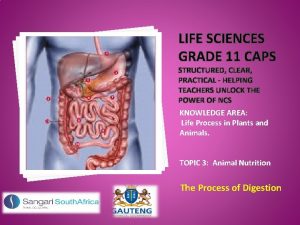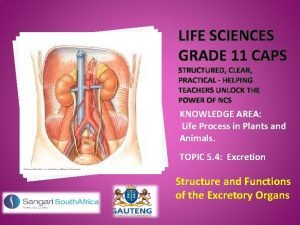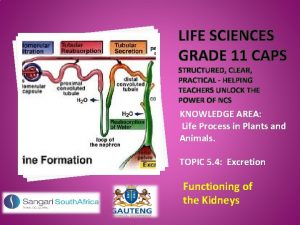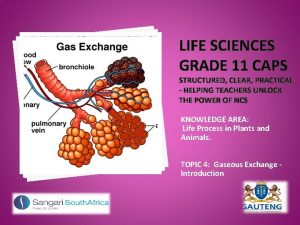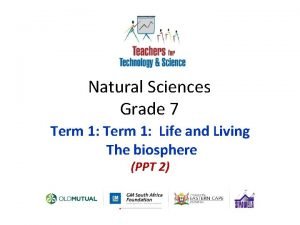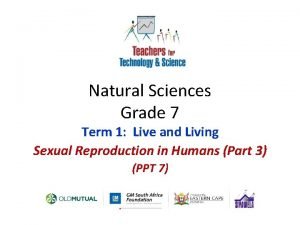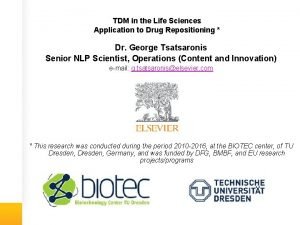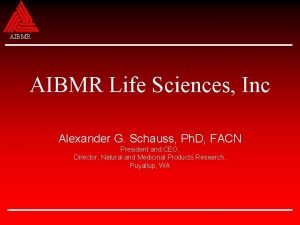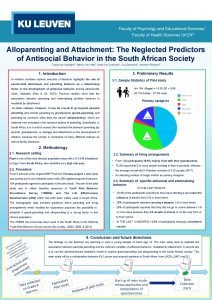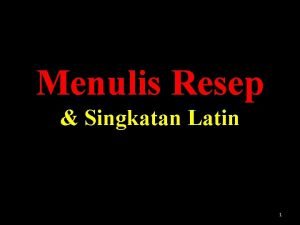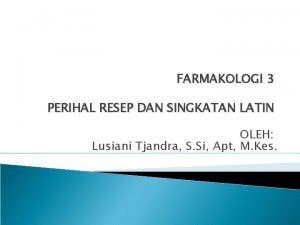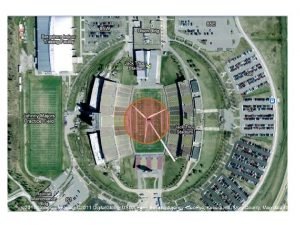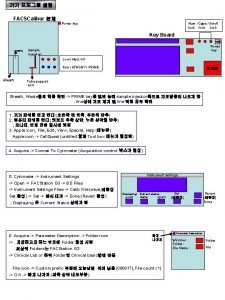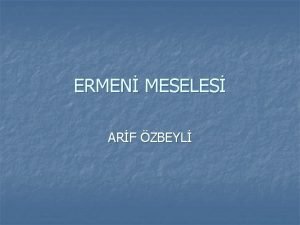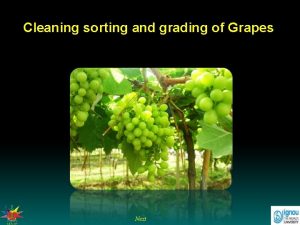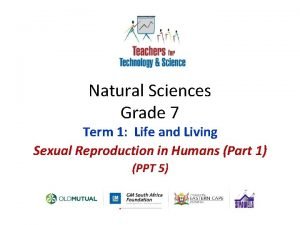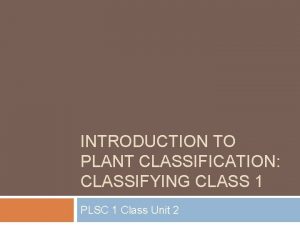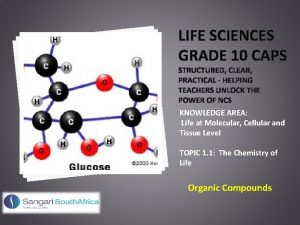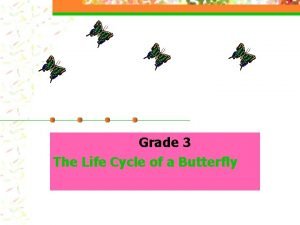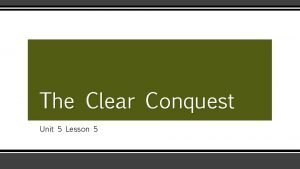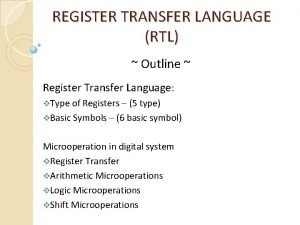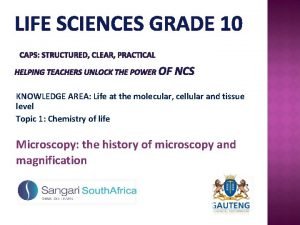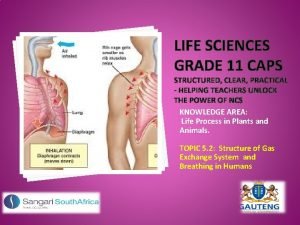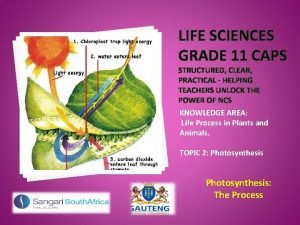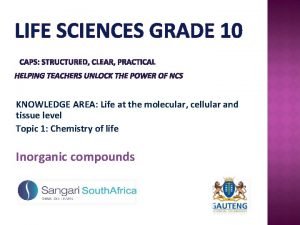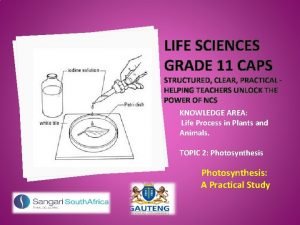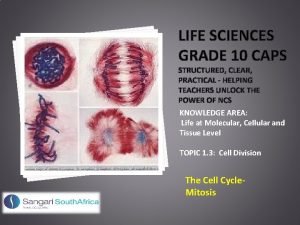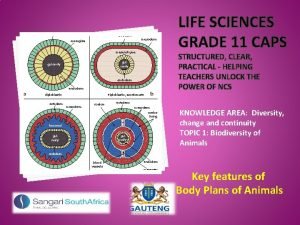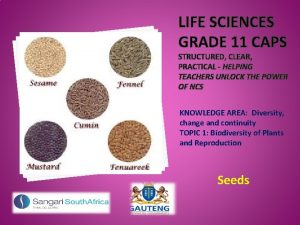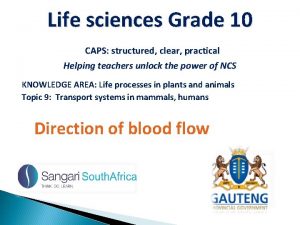LIFE SCIENCES GRADE 10 CAPS STRUCTURED CLEAR PRACTICAL



































































































- Slides: 99

LIFE SCIENCES GRADE 10 CAPS STRUCTURED, CLEAR, PRACTICAL - HELPING TEACHERS UNLOCK THE POWER OF NCS KNOWLEDGE AREA: Life Processes in Plants and Animals TOPIC 2. 1: Support and Transport Systems in Plants Anatomy of Dicotyledonous Plants

SUMMARY OF PRESENTATION Anatomy of Dicot Plants The Root The Stem Tissues Responsible for Transport and Support

ANATOMY OF DICOTYLEDONOUS PLANTS The Need Transport and Support in Plants We shall look at two reasons for the need of a transport system in plants. In order for photosynthesis to occur the plant requires water, sunlight and carbon dioxide. � Sunlight and gases enters the plant directly at the leaf where photosynthesis occurs. � But water is absorbed by the roots, a transport system must be present to carry the water from the roots to all parts of the plant. � Once the food is manufactured it must be transported to all parts of the plant from the leaves, a transport system is needed for this. �

ANATOMY OF DICOTYLEDONOUS PLANTS � But water is absorbed by the roots, a transport system must be present to carry the water from the roots to all parts of the plant. � Once the food is manufactured it must be transported to all parts of the plant from the leaves, a transport system is needed for this.

ANATOMY OF DICOTYLEDONOUS PLANTS � Most plants need to grow tall in order for the to reach the sunlight. � If these plants do not have any supporting tissue they cannot be held upright. � Therefore they need supporting tissue to hold the plant upright so that they can reach great heights in order to reach sunlight.

ANATOMY OF DICOTYLEDONOUS PLANTS So lets summarize… � Plants need… 1. Transport tissue to transport water from the roots to the leaves and food from the leaves to all parts of the plant 2. Supporting tissue to reach the sunlight.

ANATOMY OF DICOTYLEDONOUS PLANTS The Root: � The root is an example of a plant organ. � The are two types of root systems. These are the: 1. tap root system and the 2. adventitious root system. We shall look at the main differences between these two root systems

ANATOMY OF DICOTYLEDONOUS PLANTS The Tap Root: � The tap root has one main root and other smaller roots arising from it. � The main root is called the tap root. � The smaller roots that arise from it are called lateral or side roots. Tap Root System

ANATOMY OF DICOTYLEDONOUS PLANTS � The tap root arises from the radicle of the embryo found in a seed. � The radicle is the first root. � The diagram of the next slide shows us an embryo with the radicle. Tap Root System

ANATOMY OF DICOTYLEDONOUS PLANTS � The seed alongside is a dicot seed because it has 2 cotyledons. � The seed is surrounded by a seed coat called the testa. � The embryo is found in the cotyledons. A Dicot Seed

ANATOMY OF DICOTYLEDONOUS PLANTS � The embryo is made up of the first root, first shoot and the first leaves. � The first root is called the radicle. � The radicle grows into the tap root. A Dicot Seed

ANATOMY OF DICOTYLEDONOUS PLANTS Adventitious Root: adventitious root has no � The distinguishable main root all the roots are more or less the same size. � These roots do not arise from the radicle. � They arise from any other part of the plant. Adventitious Root

SOMETHING FOR YOU TO DO Name the two types of roots systems you have studied and tabulate two differences between them.

SOLUTION � Tap root system and adventitious root system. The differences between tap root system and adventitious root system Tap root system Arises from the radicle of embryo. Adventitious root system Does not arise from the radicle of embryo, it arises from any other part of the plant. Has one main from which the The main root cannot be lateral roots arise. distinguished.

ANATOMY OF DICOTYLEDONOUS PLANTS Functions of Roots: � Roots have two main functions. These are: 1. 2. They absorb water and mineral salts. They anchor the plant firmly to the ground. Now lets look at the structure in a little more detail

ANATOMY OF DICOTYLEDONOUS PLANTS External Structure of the Root Tip: � The root tip has 5 main regions has shown in the diagram alongside. These are: 1. Root cap 2. Growing point 3. Region of elongation 4. Region of root hairs 5. Mature region

ANATOMY OF DICOTYLEDONOUS PLANTS The Root Cap: � The root cap covers the root tip. � It is made up of parenchyma cells. � Some of these cells are rubbed off and damaged as the root tip pushes its way through the soil.

ANATOMY OF DICOTYLEDONOUS PLANTS Function: � The root tip protects the inner layers of the root tip.

ANATOMY OF DICOTYLEDONOUS PLANTS Growing Point: � This region is found within the root cap. � It is made up of meristematic cells. Do you remember what are meristematic cells? � This region produces new cells.

ANATOMY OF DICOTYLEDONOUS PLANTS Function: These cells of this region are used to… 1. 2. Replace the cells that are damaged or lost by the root cap. Some cells are pushed to the region of elongation.

ANATOMY OF DICOTYLEDONOUS PLANTS Region of Elongation: � � This region occurs above the growing point. These cells come from the growing point.

ANATOMY OF DICOTYLEDONOUS PLANTS Function: 1. Cells in this region elongate.

ANATOMY OF DICOTYLEDONOUS PLANTS Root Hair Region: � Found above the region of elongation. � It has the root hairs externally.

ANATOMY OF DICOTYLEDONOUS PLANTS � Internally the cells in this region start to differentiate. They start to become mature tissue. Sometimes it is also called the region of elongation. Do you remember what differentiate means?

ANATOMY OF DICOTYLEDONOUS PLANTS Function: 1. The root hairs absorb water and mineral salts.

ANATOMY OF DICOTYLEDONOUS PLANTS The Mature Region: � This is the last region of the root tip. � Externally it has lateral or side roots. � Internally it has fully differentiated tissue. Name some examples of these fully differentiated tissue?

SOLUTION: � Meristematic cells are cells that divide continuously and can become differentiated into any type of tissue. � Differentiated is when the structure of the cell changes so that it can perform a different function. � Some examples of differentiated tissues are parenchyma, sclerenchyma, collenchyma, xylem and phloem.

ANATOMY OF DICOTYLEDONOUS PLANTS Internal Structure of Young Dicot Root: � We will study the cross section of the young dicot root. � Cross section is also called a transverse section. � Transverse section can be also represented by the letters t/s. � The next slide shows a plan diagram of the t/s of young dicot root.

ANATOMY OF DICOTYLEDONOUS PLANTS Plan diagram of T/S of young dicot root

ANATOMY OF DICOTYLEDONOUS PLANTS � From the plan diagram we can see that the root is made up of 3 main regions. These 3 regions are the… 1. Epidermis 2. Cortex 3. Stele � The next shows a detailed diagram. � This shows the detail of each region which we shall now discuss.

ANATOMY OF DICOTYLEDONOUS PLANTS Detailed diagram of T/S of young dicot root

ANATOMY OF DICOTYLEDONOUS PLANTS Epidermis: � The epidermis forms the outermost layer of the root. � The epidermis is a single layer of cells. � These cells are brick shaped, thin walled and transparent. � Amongst the epidermal cells are specialized epidermal Detailed diagram of T/S of young cells called root hairs. dicot root

ANATOMY OF DICOTYLEDONOUS PLANTS Function: 1. The epidermis allows sunlight to pass through to the deeper lying tissues. 2. Since the epidermis is the outermost layer it provides the inner tissues of the root with protection. 3. The root hair is used to absorb water and mineral salts.

ANATOMY OF DICOTYLEDONOUS PLANTS The Root Hair: � The root is made up of elongated cells. � The cell wall is extremely thin. � In fact it is so thin that in places there are pores so it makes direct contact with the soil. Root hair

ANATOMY OF DICOTYLEDONOUS PLANTS � Within the cell wall there is a cell membrane. � The cell membrane surrounds the cytoplasm. � Embedded in the cytoplasm is a very large vacuole and a nucleus. Root hair

ANATOMY OF DICOTYLEDONOUS PLANTS Cortex: � The cortex lies within the epidermis. � It is made up of many layers of parenchyma cells. � The cortex ends in a single layer of cells called the endodermis. T/S root

ANATOMY OF DICOTYLEDONOUS PLANTS � The endodermis is thickened by a substance called suberin. � This suberin is laid down on the inner and radial walls. � Since the endodermis is thickened by suberin Endodermis showing suberin we say that the endodermis is suberised.

ANATOMY OF DICOTYLEDONOUS PLANTS The strip of suberin is called the Casparian strip. � The Casparian strip is waterproof. � Between the thickened endodermal cells there are unthickened cells. � These unthickened cells are called passage cells. � These passage cells are found opposite the xylem arms of the stele. � These cells will allow water to pass through. Diagram showing Passage cells �

ANATOMY OF DICOTYLEDONOUS PLANTS Function: 1. With the passage cells the endodermis directs the movement of water through the root into the xylem.

ANATOMY OF DICOTYLEDONOUS PLANTS Stele: � � � The stele is also known as the vascular cylinder. It is made up of 4 different types of tissue. These are the pericycle, xylem, cambium and phloem. Diagram showing the Stele

ANATOMY OF DICOTYLEDONOUS PLANTS – THE ROOT The pericycle is found immediately below the endodermis. � It is made up of thin walled cells. � The xylem is found at the center of the stele. � The xylem has a number of arms radiating outwards. � This gives the xylem its star shaped or cross appearance. � The phloem is found in the arms of the xylem. � Diagram showing the Stele

ANATOMY OF DICOTYLEDONOUS PLANTS � The vascular cambium is found between the xylem and phloem. Functions: 1. The pericycle gives rise to lateral roots. 2. The xylem transports water and mineral salts from the roots to all parts of the plant. 3. The phloem transports manufactured food from the leaves to all parts of the plant. 4. The vascular cambium gives rise to more xylem and phloem as the root increases in thickness.

ANATOMY OF DICOTYLEDONOUS PLANTS Distinguishing Features of a Root: These features will help you tell the difference between the root and stem and will also help you to identify the root. 1. The presence of root hairs. 2. A clearly defined endodermis. 3. The presence of a central stele. 4. The star shaped xylem. 5. Xylem alternates with the phloem.

SOMETHING FOR YOU TO DO Study the diagram and answer the questions that follow: 1. Identify the organ shown. 2. Give 3 visible reasons for your answer above. 3. Provide labels for B and C. 4. Identify cell A. Explain how it is adapted for its function. 5. Label D is the xylem. Give 1 visible reason for your answer. A B c D

SOLUTION 1. 2. 3. 4. 5. Root. Presence of a well defined endodermis. Star shaped xylem. Xylem alternates with the phloem. Presence of a central stele. B- cambium C-phloem A- passage cell. It is unthickened and occurs in line with arms of the xylem to allow for easy entry of water into xylem. It is round in cross section.

ANATOMY OF DICOTYLEDONOUS PLANTS The Stem: External Structure: � Stems are found above the ground. � They are cylindrical and erect. � Stem are green in colour when young due to the presence of chloroplasts. External Structure of Stem

ANATOMY OF DICOTYLEDONOUS PLANTS � Leaves and buds arise from the stem. � The part of the stem from which the leaf arises is called the node. � The part between 2 nodes is called the internode. External Structure of Stem

ANATOMY OF DICOTYLEDONOUS PLANTS � The stem has two types of buds. � These are the terminal bud and the axillary bud. � The terminal bud is also called the apical bud. � The terminal bud is found at the tips of stems. Diagram showing buds

ANATOMY OF DICOTYLEDONOUS PLANTS � The axillary bud is found in the axil. � The axil is the area between the leaf and the stem. Diagram showing buds

ANATOMY OF DICOTYLEDONOUS PLANTS Internal Structure of Young Dicot Stem: � We shall look at the cross section of a young dicot stem. � Look at the next 2 slides that show plan and detailed diagram of the young dicot stem.

ANATOMY OF DICOTYLEDONOUS PLANTS The Plan Diagram of the Dicot Stem. � The diagram shows us that the stem is made up of 4 regions. Plan Diagram of T/S of Young Dicot Stem

ANATOMY OF DICOTYLEDONOUS PLANTS These are the: 1. 2. 3. 4. Epidermis Cortex Vascular bundles Pith We shall now look at each of these 4 regions in detail. Plan Diagram of T/S of Young Dicot Stem

ANATOMY OF DICOTYLEDONOUS PLANTS Detailed diagram of T/S of Young Dicot Stem

ANATOMY OF DICOTYLEDONOUS PLANTS Epidermis: � The epidermis is covered by a transparent cuticle. � It is made up of single layer of cells. � These cells are Epidermis of Stem transparent, thin walled cells.

ANATOMY OF DICOTYLEDONOUS PLANTS � Specialized epidermal cells called guard cells maybe found amongst the epidermal cells. � These guard cells have the same structure discussed earlier in the leaf.

ANATOMY OF DICOTYLEDONOUS PLANTS Function: 1. The transparent cuticle allows for sunlight to pass through 2. The cuticle also reduces water loss by transpiration. 2. As the outermost layer the epidermis protects the inner lying tissue. 3. The guard cells allow for gaseous exchange.

ANATOMY OF DICOTYLEDONOUS PLANTS Cortex: � The cortex is found within the epidermis. � Sometimes immediately below the epidermis there are layers of collenchyma or sclerenchyma. These layers make up the hypodermis. � The micrographs show 2 of the 3 tissues

ANATOMY OF DICOTYLEDONOUS PLANTS � Here is a micrograph of the sclerenchyma

ANATOMY OF DICOTYLEDONOUS PLANTS � Form the diagram you can see the sclerencyhma cells are evenly thickened. Sclerenchyma tissue is made up of sclerenchyma fibers and stone cells. The fibers have tapered ends. � Collenchyma is only thickened in the corners.

ANATOMY OF DICOTYLEDONOUS PLANTS � The sclerenchyma of the hypodermis is made up of sclerenchyma fibers only. � Below the hypodermis is the parenchyma. � The parenchyma is made up of thin-walled irregularly shaped cells, with large intercellular spaces. � The final layer of the cortex is the endodermis. � The endodermis forms a single layer. � The endodermis of the stem is not clearly visible.

ANATOMY OF DICOTYLEDONOUS PLANTS Function: 1. 2. 3. 4. The hypodermis strengthens the stem and helps to keep it upright. The parenchyma stores food. The intercellular airspaces of the parenchyma are used for the transport of water and gases. The endodermal cells store starch.

ANATOMY OF DICOTYLEDONOUS PLANTS Vascular Bundles: � The vascular bundles have a circular arrangement around the pith. Arrangement of Vascular Bundles

ANATOMY OF DICOTYLEDONOUS PLANTS Each vascular bundle has the following structure � It has a sclerenchyma cap made up of sclerenchyma fibers right on the outside. � The phloem tissue is found below the sclerenchyma cap. � This is followed by the vascular cambium. � Then immediately below the cambium is the xylem.

ANATOMY OF DICOTYLEDONOUS PLANTS Function: 1. 2. 3. The sclerenchyma fibers provides the plant with strength and helps to keep it upright. The xylem transports water and mineral salts from roots to all parts of the plant. The phloem transports manufactured food from the leaves to all parts of the plants.

THE TISSUES RESPONSIBLE FOR TRANSPORT AND SUPPORT � The tissues that are responsible for transport and support are xylem, phloem, sclerenchyma and collenchyma. � All these tissues have been discussed earlier, but there is a little new information to consider. The tissues responsible for transport are xylem and phloem.

THE TISSUE RESPONSIBLE FOR TRANSPORT AND SUPPORT XYLEM: � This tissue is found in the stele of roots, in the vascular bundle of stems and in the veins of leaves. � The structure of xylem tissue has been discussed already. � However we want to discuss the thickening in a little more detail. � Remember xylem vessels are thickened with lignin. � The lignin may be laid down in four patterns or arrangements. These are as follows:

THE TISSUE RESPONSIBLE FOR TRANSPORT AND SUPPORT 1. 2. 3. 4. The lignin maybe laid down in circles or have a circular arrangement. This pattern is called annular thickening. The lignin may have a spiral arrangement. This is known as spiral thickening. The thickening may have a ladder like arrangement. This is called sclariform thickening. Sometimes the whole wall is thickened. There are some unthickened areas. These unthickened areas are called pits. This type of thickening is called whole wall or pitted thickening.

THE TISSUE RESPONSIBLE FOR TRANSPORT AND SUPPORT B- annular thickening C- spiral thickening D- sclariform thickening E- reticular thickening F- pitted thickening G- pitted thickening

THE TISSUE RESPONSIBLE FOR TRANSPORT AND SUPPORT � With the continuous movement of water up the xylem tissue it is possible for the xylem to become distorted. � This means to lose their shape. � However this does not happen because the xylem vessels and tracheids are adapted to make them strong so that they are able to maintain their shape. They are adapted in the following way: 1. The vessels and tracheids are thick walled. 2. They are round in cross section. Structures that are round have additional strength.

THE TISSUE RESPONSIBLE FOR TRANSPORT AND SUPPORT Phloem: � Phloem is found in the stele of the root, in the vascular bundle of stems and in the vein of leaves. � There only a few additions to add to what we have already learnt. . � Phloem is made up of two types of cells; the sieve tube and the companion cell. � The sieve tube has cross walls called sieve plates. � Remember the companion cells also have cross walls.

THE TISSUE RESPONSIBLE FOR TRANSPORT AND SUPPORT � Collenchyma and sclerenchyma provide the plant with strength and support. Collenchyma: � The collenchyma occurs as the hypodermis in some young stems. � Remember that these are brick shaped cells in surface and side view, and they are thick walled. � But only the corners of the cells are thickened.

THE TISSUE RESPONSIBLE FOR TRANSPORT AND SUPPORT Function: 1. The collenchyma tissue gives strength and support to the aerial parts of the plant. Sclerenchyma: � � Sclerenchyma is made up of the fibers and stone cells. The sclerenchyma fibers occurs as a cap on the vascular bundle of the dicot stem. It may also occur as the hypodermis in some stems. The fibers as mentioned earlier, have tapered ends, thick cell walls and very small lumens.

THE TISSUE RESPONSIBLE FOR TRANSPORT AND SUPPORT Lumens are the inner cavities of cells. � The stone cells are small cells. � They may be round to oval, irregularly shaped cells. � They have very thick cell walls. � The cell walls are so thick that their lumens are almost completely blocked. � Sclerenchyma tissue

THE TISSUE RESPONSIBLE FOR TRANSPORT AND SUPPORT Function: 1. Sclerenchyma provides mechanical support to the plant.

TERMINOLOGY � Tap root: has one main root and other smaller roots arising from it. � Radicle: is the first root. � Adventitious root: has no distinguishable main root all the roots are more or less the same size. � Suberin: is the thickening that is laid down on the inner and radial walls of the endodermis. � Casparian strip: is a strip of thickening of the endodermal cells � Passage cells: are the unthickened cells of the endodermis.

TERMINOLOGY � Axil: is the area between the leaf and the stem. � Apical or terminal buds: are found at the tips of stems. � Axillary buds: are found in the axil between the stem and the leaf. � Hypodermis: is the layers of collenchyma or sclerenchyma tissue found immediately below the epidermis of the stem. � Whole wall thickening: is when lignin is laid down on the entire xylem wall, with some unthickened portions.

TERMINOLOGY � Pits: are the unthickened portion of the xylem walls that are not thickened by lignin during pitted thickening. � Spiral thickening: refers to the spiral arrangement of the lignin on the xylem wall. � Sclariform thickening: refers to the ladder like arrangement of the lignin on the xylem wall. � Annular thickening: refers to circular or ring like arrangement of the lignin on the xylem wall.

TERMINOLOGY � Distorted: this means to lose their shape. � Sieve plates: are the cross walls of the sieve tubes. � Lumens: are the inner cavities of cells.

QUESTION 1 1. This made up of fibers and stone cells. A. Xylem B. Phloem C. Sclerenchyma D. Collenchyma

QUESTION 2 2. The tissue that is made up brick shape cell that are thickened in the corners only. A. Xylem B. Phloem C. Sclerenchyma D. Collenchyma

QUESTION 3 3. The tissue who has transport function, with thin walled living cells. A. Xylem B. Phloem C. Sclerenchyma D. Collenchyma

QUESTION 4 4. The tissue that is made up of sieve tubes and companion cells. A. Xylem B. Phloem C. Sclerenchyma D. Collenchyma

QUESTION 5 5. The tissue that is made up of dead cells and no cross walls. A. Xylem B. Phloem C. Sclerenchyma D. Collenchyma

QUESTION 6 6. The thickening that is laid down on the xylem vessel is… A. Lignin B. Suberin C. Casparian strip D. None of the above

QUESTION 7 7. Xylem cells that are round in cross-section… A. Are the vessels. B. Provides extra strength to prevent distortion C. A only D. Both A and B.

QUESTION 8 8. Choose the correct answer. LETTER A. B. C. TISSUE xylem phloem collenchyma STRUCTURE lignin suberin Thick cell walls FUNCTION support strength Transport D. xylem Cross wall present transport

QUESTION 9 9. B on this diagram shows… A. Annular thickening B. Spiral thickening C. Pitted thickening D. Scalariform thickening

QUESTION 10 10. The micrograph is of a… A. Root B. Stem C. Stele D. Vascular bundle

QUESTION 11 11. Write down the letter of the tissue that is involved in transport only. A. B B. C C. D D. A

QUESTION 12 12. The tissues that may form the hypodermis is… A. A and B B. C and D C. A and C D. B and D A C B D

QUESTION 13 13. The tissue found between the xylem and phloem in the vascular bundle is the… A. Cambium B. Sclerenchyma C. Collenchyma D. Endodermis

QUESTION 14 14. The layer that contains the Casparian Strip is the… A. Hypodermis B. Epidermis C. Endodermis D. Pericycle

QUESTION 15 15. The passages cells are found amongst the cells of the… A. Hypodermis B. Epidermis C. Endodermis D. Pericycle

QUESTION 16 16. The layer that gives rise to the lateral roots is the… A. Hypodermis B. Epidermis C. Endodermis D. Pericycle

QUESTION 17 17. The layer that is able to provide protection and is transparent to transmission of sunlight is… A. Hypodermis B. Epidermis C. Endodermis D. Pericycle

QUESTION 18 18. In the vascular bundle the… A. Phloem is found on the outside and xylem is found on the inside. B. Xylem is found on the outside and phloem is found on the inside. C. Xylem alternates with the phloem. D. Xylem alternates with the sclerenchyma fibers.

QUESTION 19 19. The apical bud is… A. Found at the tip of the stem B. Found in the axil C. Between the leaf and stem. D. A and C

QUESTION 20 20. The specialized epidermal cells that absorbs water and mineral salts is the… A. Guard cell B. Root hair C. Sieve tube D. Sieve plate

SOLUTION: 1. 2. 3. 4. 5. 6. 7. 8. 9. 10. C D B B A A D A A C 11. 12. 13. 14. 15. 16. 17. 18. 19. 20. A C C D B A A B
 Human nutrition grade 11
Human nutrition grade 11 Natural sciences tok
Natural sciences tok Types of interviews structured semi structured unstructured
Types of interviews structured semi structured unstructured How can we integrate oop with sd/sa
How can we integrate oop with sd/sa In march
In march Malpighian body
Malpighian body Life science grade 11 kidney practical
Life science grade 11 kidney practical Gaseous exchange grade 11 practical
Gaseous exchange grade 11 practical Maps and plans grade 12
Maps and plans grade 12 Grade 6 natural science term 3
Grade 6 natural science term 3 Natural science grade 7
Natural science grade 7 Ns grade 7 term 4
Ns grade 7 term 4 Natural science grade 7 term 3 notes
Natural science grade 7 term 3 notes Natural science and technology grade 6 term 4
Natural science and technology grade 6 term 4 Nst grade 4 term 2
Nst grade 4 term 2 Animal nutrition grade 11 practical
Animal nutrition grade 11 practical Properties of materials grade 7
Properties of materials grade 7 Natural science grade 7
Natural science grade 7 Swedish life sciences
Swedish life sciences Ibm healthcare and life sciences
Ibm healthcare and life sciences Data integration in the life sciences
Data integration in the life sciences Paralax life sciences
Paralax life sciences Colors life sciences
Colors life sciences Life sciences
Life sciences Cti life sciences fund
Cti life sciences fund Life sciences sector skill development council
Life sciences sector skill development council Ibm healthcare and life sciences
Ibm healthcare and life sciences Swiss life sciences
Swiss life sciences Meril life sciences
Meril life sciences Alexander g. schauss
Alexander g. schauss Life sciences universal data framework
Life sciences universal data framework Mcb 151
Mcb 151 Psycholgy
Psycholgy Ctx life sciences pvt. ltd.
Ctx life sciences pvt. ltd. Polynomials in everyday life
Polynomials in everyday life Caps saude mental
Caps saude mental Sig e caps
Sig e caps Contoh resep magistralis
Contoh resep magistralis Sigecaps
Sigecaps Subject improvement plan for maths
Subject improvement plan for maths Sigicaps
Sigicaps Fiu caps
Fiu caps Singkatan resep
Singkatan resep Sig e caps
Sig e caps Maths caps document intermediate phase
Maths caps document intermediate phase History fet caps
History fet caps Caps 71-1
Caps 71-1 Spar cap
Spar cap Caps and floors
Caps and floors Abridged caps document
Abridged caps document Sigecaps questions
Sigecaps questions Get your thinking caps on
Get your thinking caps on Ice cube aon
Ice cube aon Cap floor e collar
Cap floor e collar Cerner riverport campus
Cerner riverport campus Radical days of the revolution
Radical days of the revolution Hair washing cap
Hair washing cap All caps
All caps Caps mcgill
Caps mcgill Caps topic
Caps topic ㄴㅊ개ㅣㅣㅣㄷㄱ.채ㅡ
ㄴㅊ개ㅣㅣㅣㄷㄱ.채ㅡ Scrubbing the hub vs curos caps
Scrubbing the hub vs curos caps What goes around the earth
What goes around the earth Enver paşa ermeniler
Enver paşa ermeniler Caps saude mental
Caps saude mental Rx template
Rx template Caps document intermediate phase
Caps document intermediate phase Mcgill ics
Mcgill ics Harald blaatand caps
Harald blaatand caps Initial to transmuted grade
Initial to transmuted grade Cinderella dressed in yella jump rope song lyrics
Cinderella dressed in yella jump rope song lyrics What is the white part of an egg called
What is the white part of an egg called Milk grade
Milk grade Grade grade
Grade grade Metamorphic grade
Metamorphic grade Substance abuse grade 8 life orientation
Substance abuse grade 8 life orientation Life orientation grade 12 human rights violations
Life orientation grade 12 human rights violations Grade 7 life orientation term 1 notes
Grade 7 life orientation term 1 notes Computer part of your life grade 11
Computer part of your life grade 11 Computers part of your life grade 11 memo
Computers part of your life grade 11 memo Life orientation grade 7 self image
Life orientation grade 7 self image Life and living grade 7
Life and living grade 7 Storyline online
Storyline online Unhealthy roots
Unhealthy roots Organic compounds grade 10 life science
Organic compounds grade 10 life science Butterfly life cycle for grade 3
Butterfly life cycle for grade 3 Social and environmental responsibility grade 12
Social and environmental responsibility grade 12 Life orientation grade 7 term 2 activities
Life orientation grade 7 term 2 activities Tadapole
Tadapole Naviance clear springs
Naviance clear springs What is a fluid diet
What is a fluid diet Clear perinatal quality
Clear perinatal quality The clear conquest
The clear conquest Last clear chance doctrine
Last clear chance doctrine Ice pops clear liquid diet
Ice pops clear liquid diet Is having a clear perception of your personality
Is having a clear perception of your personality Edwin morgan message clear
Edwin morgan message clear What is register transfer logic
What is register transfer logic Punctuation marks make meaning clear.
Punctuation marks make meaning clear. Pic b
Pic b
